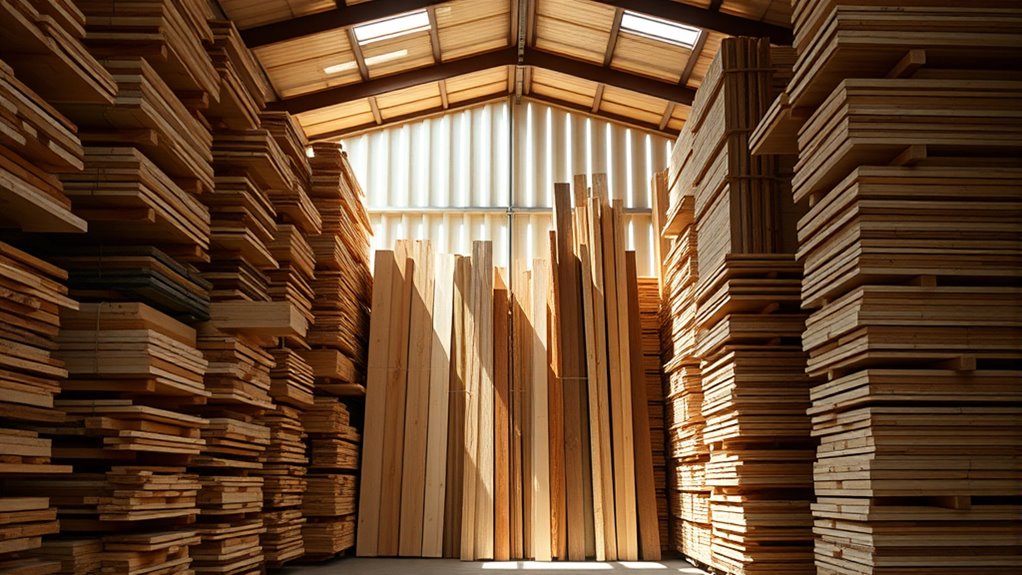To store lumber vertically without warping, make certain each piece is properly supported at the bottom and lean at a gentle angle against a wall or vertical rack designed for stability. Use spacers or stickers between boards to promote airflow and prevent moisture buildup. Elevate the wood on sturdy supports to avoid contact with damp surfaces, and regularly inspect for signs of moisture or deformation. If you keep these tips in mind, you’ll be able to maintain straight, warping-free lumber over time.
Key Takeaways
- Store lumber upright on a stable, flat surface with even support at the bottom to prevent bending.
- Use spacers or stickers between boards to promote airflow and reduce moisture retention.
- Lean lumber gently at a slight angle against a wall or vertical rack designed for support.
- Elevate stored lumber on sturdy racks to allow air circulation underneath and minimize contact with damp surfaces.
- Regularly inspect for warping or moisture issues, and ensure the storage area remains dry and well-ventilated.

Have you ever wondered if storing lumber vertically is the best way to keep it in good condition? If so, you’re not alone. Many DIYers and professionals prefer vertical storage because it saves space and makes individual pieces easier to access. However, to prevent warping and damage, you need to pay close attention to moisture control and stacking techniques. Properly managing these factors helps guarantee your lumber remains straight and usable over time.
First, moisture control is essential when storing lumber vertically. Wood is highly susceptible to changes in humidity, which can lead to warping, twisting, or cracking. Before storing, make sure your lumber is properly dried and acclimated to the environment where it will be kept. If the wood still contains excess moisture, store it in a dry, well-ventilated space to allow it to stabilize. Using a dehumidifier or ensuring good air circulation can greatly reduce moisture buildup. When storing vertically, avoid placing the wood directly against damp walls or concrete floors, as these surfaces can transfer moisture. Instead, elevate your lumber on sturdy racks or supports that promote airflow underneath and around each piece.
Moisture control is vital; keep lumber dry and well-ventilated to prevent warping when stored vertically.
Stacking techniques are equally important for preventing warping when storing wood vertically. You should stand your lumber upright on a flat, stable surface, making sure the bottom end is supported evenly. It’s best to lean the pieces against a wall or rack designed for vertical storage, but do so gently to avoid bending or putting uneven pressure on the wood. To maintain shape and prevent warping, stack the lumber with spacers or stickers—thin strips of wood placed between boards—if you’re stacking multiple pieces. These spacers allow air to circulate around each plank, reducing moisture buildup and promoting even drying. When stacking, keep the load balanced and avoid leaning the wood at an angle, which could cause warping over time. Additionally, consider applying wood stabilizers to help preserve the wood’s shape during storage.
Regular inspection is indispensable. Check your stored lumber periodically for signs of moisture retention or deformation. If you notice any warping or excessive moisture, address the issue immediately by adjusting ventilation or removing affected pieces. Remember, the goal is to keep your lumber dry and supported properly to maintain its integrity. By combining effective moisture control with proper stacking techniques, you’ll greatly reduce the risk of warping and guarantee your wood stays straight and ready for use whenever you need it. Storing lumber vertically can be a smart choice, but only if you pay attention to these key factors. Proper care now means less trouble down the line, saving you time, effort, and money.
Frequently Asked Questions
What Types of Lumber Are Best Stored Vertically?
When storing lumber vertically, you want to choose wood types that resist warping, like cedar or redwood. Proper wood treatment before storage can also help prevent damage. Use sturdy storage racks to keep the boards upright and well-supported, ensuring even weight distribution. This setup minimizes bowing or twisting over time. Always guarantee good air circulation around your lumber to keep it dry and maintain its shape during storage.
How Does Humidity Affect Vertical Lumber Storage?
You might think humidity doesn’t matter much, but it truly affects vertical lumber storage. High humidity increases wood moisture, causing it to warp or twist over time. Conversely, low humidity dries out the wood, leading to cracks. To keep your lumber in top shape, you need to regulate the environment carefully, maintaining consistent humidity levels. Proper environmental control ensures your wood stays stable, preventing warping and preserving its quality for future use.
Can Stored Lumber Develop Mold or Pests?
When you store lumber, mold and pests can become a concern if the wood isn’t properly treated. You should use wood treatment to prevent mold growth and apply pest prevention measures, like regular inspections and sealing cracks. Keeping the storage area dry and well-ventilated also helps. This way, you protect your lumber from damage, ensuring it stays in good condition until you’re ready to use it.
How Often Should I Check My Stored Lumber?
You should check your stored lumber at least once a month to guarantee it stays in good condition. During inspections, look for signs of mold or pests and adjust storage conditions if needed. Proper wood treatment can help prevent issues, and maintaining appropriate stack spacing allows air circulation. Regular checks help you catch problems early, ensuring your vertically stored lumber remains straight and undamaged over time.
What Tools Are Recommended for Organizing Vertical Stacks?
To keep your lumber organized, you should use tools like shelf dividers and a clear labeling system. Shelf dividers help separate different types or sizes of wood, preventing shifting and damage. A labeling system keeps track of each stack’s contents, making it easy to find what you need without disturbing the arrangement. Together, these tools streamline organization and help maintain your lumber’s quality over time.
Conclusion
Remember, a stitch in time saves nine, so take care when storing your lumber vertically. By keeping the boards flat, off the ground, and supported evenly, you’ll prevent warping and extend their lifespan. Proper storage might take a little effort now, but it’ll save you time and money later. Treat your lumber well, and it’ll reward you with lasting strength and quality. Follow these tips, and your wood will stay straight and sturdy for years to come.









